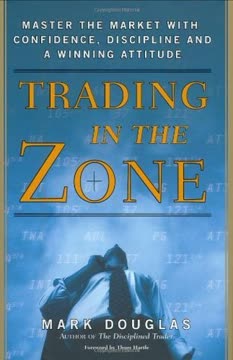Key Takeaways
1. Know Thyself: Understand Your Trading Motivations
Know why you are doing a trade before you trade.
Motivation matters. Understanding your motivations for trading is crucial because it directly impacts your decision-making process. Are you trading to make money, to seek intellectual validation, to alleviate boredom, or to satisfy a risk-seeking appetite? Recognizing these underlying drivers helps you avoid emotional traps and make more rational choices.
Irrationality abounds. Human beings are not perfectly rational profit maximizers. Cognitive biases, such as overconfidence, hindsight bias, and the Dunning-Kruger effect, can cloud judgment and lead to poor trading decisions. Being aware of these biases is the first step in mitigating their influence.
Self-awareness is key. By understanding your motivations, you can better protect yourself from being exploited by others who may be aware of your weaknesses. This self-knowledge allows you to structure your trading approach to minimize the impact of non-profit-driven desires, leading to more consistent and profitable outcomes.
2. Adverse Selection is Inevitable: Embrace Discomfort
You're never happy with the amount you traded.
Information asymmetry. Adverse selection arises from information asymmetry, where one party in a transaction has more knowledge than the other. This is a fundamental aspect of trading, leading to the realization that you'll never be completely satisfied with the outcome of a trade.
Relative knowledge matters. Your absolute level of knowledge is less important than your knowledge relative to your counterparty. The goal is to be better informed than the person on the other side of the trade, allowing you to make more advantageous decisions.
Bayesian updating. Markets are constantly evolving as new information becomes available. Successful traders must continuously update their beliefs based on market signals, such as price movements and the actions of other participants. This iterative process of belief-updating is essential for navigating the complexities of trading.
3. Risk Management is Paramount: Hedge or Be Humbled
Take only the risks you're being paid to take. Hedge the others.
Define your capital. Capital is the lifeblood of trading, and understanding its true value is essential. It's not just about the money in your account, but also the opportunity cost of using that capital for one trade versus another.
Hedging reduces exposure. Hedging involves taking offsetting positions to reduce or eliminate unwanted risks. By hedging out risks you're not being paid to take, you can focus on the specific risk factors where you have an edge, increasing your chances of profitability.
Risk comes in many forms. Market risk is the most obvious, but counterparty risk, liquidity risk, model risk, operational risk, technological risk, and reputational risk all play a role. A comprehensive risk management strategy addresses all of these potential pitfalls.
4. Liquidity is King: Prioritize Tradability
Put on a risk using the most liquid instrument for that risk.
Liquidity defined. Liquidity refers to the ease and speed with which an asset can be bought or sold without significantly affecting its price. High liquidity is crucial for minimizing transaction costs and managing risk effectively.
Liquidity is relative. The perceived liquidity of a market depends on the size of your trade, the frequency with which you trade, and your level of sophistication. What may be liquid for a retail investor may be illiquid for a large fund.
Liquidity affects strategy. Always consider the liquidity implications of your trading strategy. Illiquid positions can be difficult to exit, especially during times of market stress, potentially leading to significant losses.
5. Edge is a Story: Tell it Simply and Defensibly
If you can't explain your edge in five minutes, you don't have a very good one.
Edge defined. Edge is the reason why a trade makes money, the unique insight or advantage you possess that allows you to profit consistently. It's the story you tell yourself to justify taking a particular risk.
Simplicity is key. A good edge should be easily explainable. Complex, convoluted explanations are often a sign of overthinking or a lack of true understanding.
Combat biases. Be aware of cognitive biases, such as overconfidence and confirmation bias, that can cloud your judgment and lead to false perceptions of edge. Seek out dissenting opinions and challenge your own assumptions.
6. Models Express Edges: Simplify, Test, and Adapt
The model expresses the edge.
Models simplify complexity. Models are useful simplifications of the real world, allowing you to make predictions and informed decisions. However, all models are inherently flawed and should be treated with caution.
Generative vs. phenomenological. Generative models attempt to capture the underlying mechanisms driving market behavior, while phenomenological models focus on describing observed patterns. Both types have their strengths and weaknesses.
Test and validate. Rigorously test your models using historical data and out-of-sample validation techniques. Be wary of overfitting, where a model performs well on past data but fails to generalize to new situations.
7. Costs Erode Edge: Scrutinize Every Expense
If you think your costs are negligible relative to your edge, you're wrong about at least one of them.
Costs are multifaceted. Trading costs extend beyond brokerage fees and commissions. They include market impact, opportunity costs, and the often-overlooked cost of trade depreciation.
Trade depreciation. The very act of trading profitably can erode the profitability of the trade over time, as others copy your strategy and compete away your edge. This is an invisible linear cost that must be accounted for.
Minimize and monitor. Scrutinize every expense and actively seek ways to minimize costs. Regularly monitor your trading performance to identify any signs of cost creep or trade depreciation.
8. Markets Evolve: Adapt or Perish
If you're not getting better, you're getting worse.
Markets are dynamic. Financial markets are constantly evolving, driven by technological advancements, regulatory changes, and the actions of other participants. A trading strategy that works today may not work tomorrow.
Adaptability is essential. Successful traders must be adaptable and willing to continuously learn and evolve their strategies. This requires a commitment to ongoing research, experimentation, and a willingness to abandon outdated approaches.
Embrace change. View market changes as opportunities for innovation and growth. By staying ahead of the curve, you can identify new edges and maintain a competitive advantage.
9. Incentives Matter: Align Interests for Success
Working to align everyone's interests is time well spent.
Agency problems. Misaligned incentives can lead to suboptimal outcomes. It's crucial to structure your trading operation to ensure that the interests of all participants are aligned.
Incentive structures. Consider the incentives of brokers, lenders, and other counterparties. Design your trading strategies to minimize conflicts of interest and maximize mutual benefit.
Culture of alignment. Foster a culture of transparency, collaboration, and shared success. This can help to mitigate agency problems and promote a more cohesive and productive work environment.
10. Technology is a Double-Edged Sword: Master it or Be Overwhelmed
If you don't master technology and data, you're losing to someone who does.
Data is power. In today's markets, data is a crucial resource. Successful traders must be proficient in data analysis, statistical modeling, and other quantitative techniques.
Technology is essential. Modern trading relies heavily on technology, from high-speed trading systems to sophisticated risk management tools. Mastering these technologies is essential for staying competitive.
Human oversight is crucial. While technology can automate many tasks, human oversight is still necessary to manage risk, adapt to changing market conditions, and identify new opportunities.
11. Humility is Essential: Embrace Continuous Learning
Just because something has never happened doesn't mean it can't.
Markets defy prediction. Financial markets are complex systems with inherent randomness. Avoid hubris and recognize the limits of your knowledge and abilities.
Embrace uncertainty. Be prepared for the unexpected and develop strategies for managing unforeseen events. Acknowledge that even the best models can fail.
Continuous learning. Commit to a lifelong pursuit of knowledge and understanding. Stay curious, challenge your assumptions, and never stop learning from your mistakes.
Last updated:
FAQ
What is The Laws of Trading by Agustin Lebron about?
- Comprehensive trading framework: The book distills trading into 11 core laws, offering a practical guide to better decision-making in financial markets and everyday life.
- Universal application: Lebron argues that trading principles apply to all competitive environments, not just finance, making the book relevant for a wide audience.
- Focus on mental tools: It provides readers with mental models to understand risk, competition, and motivation, helping them navigate uncertainty more effectively.
- Interdisciplinary insights: The book draws from statistics, behavioral science, economics, and technology to explain how to thrive in complex, competitive systems.
Why should I read The Laws of Trading by Agustin Lebron?
- Bridges theory and practice: The book offers actionable advice on building trading models, managing data, and understanding costs, making it valuable for both beginners and experienced traders.
- Improves decision-making: By studying trading, readers develop critical thinking skills for handling uncertainty, risk, and incentives in any field.
- Demystifies trading: Lebron challenges common misconceptions, such as the idea that trading is a zero-sum game, and explains how most trades create mutual benefit.
- Broader life lessons: The principles extend beyond trading, offering tools for better decisions in business, negotiations, and personal life.
What are the key takeaways from The Laws of Trading by Agustin Lebron?
- Trading is everywhere: Understanding trading laws helps in all areas of life where decisions under uncertainty are made.
- Know your motivations: Self-awareness about why you trade or make decisions is crucial to avoid being exploited and to improve outcomes.
- Edge and models matter: Sustainable success depends on having a real edge and expressing it through robust, adaptable models.
- Adaptation is essential: Continuous improvement and adaptation are necessary to survive and thrive in competitive environments.
What are the 11 laws or core concepts in The Laws of Trading by Agustin Lebron?
- Motivation: Know why you are trading or making a decision before you act.
- Adverse selection: Recognize that information asymmetry can put you at a disadvantage.
- Risk: Understand and quantify the risks you are taking, and only take risks you are paid to take.
- Liquidity: Use the most liquid instruments to manage risk and avoid unnecessary costs.
- Edge: Clearly define and validate your edge; if you can't explain it simply, it may not exist.
- Models: Models should express your edge and be robust, transparent, and adaptable.
- Costs: Be aware of all costs—visible, invisible, linear, and nonlinear—that can erode profitability.
- Data: Use relevant, high-quality data and avoid overfitting or exhausting informational value.
- Adaptation: Continuously update strategies and models to keep up with market evolution.
- Alignment: Ensure incentives are aligned within organizations to avoid agency problems.
- Human vs. machine: Leverage the complementary strengths of humans and machines for superior decision-making.
How does Agustin Lebron define and explain "edge" in The Laws of Trading?
- Edge as unique advantage: An edge is something you know or can do that others cannot, giving you a positive expected value in trades.
- Simple and clear: If you can't explain your edge in five minutes, it's probably not robust or real.
- Validation is critical: Edges are often small and fragile, requiring careful testing and ongoing adaptation to remain effective.
- Guard against biases: Overconfidence and confirmation bias can lead traders to believe they have an edge when they do not.
What is the role of models in expressing edge according to The Laws of Trading by Agustin Lebron?
- Models express the edge: A good model must accurately and robustly represent the edge it is designed to exploit.
- Types of models: Models can be generative (based on underlying mechanisms) or phenomenological (based on observed patterns), each with strengths and limitations.
- Robustness and transparency: Effective models are robust to parameter changes, transparent, and modular, allowing for inspection and improvement.
- Human and machine synergy: Models should pragmatically split tasks between human intuition and machine computation for optimal results.
How does The Laws of Trading by Agustin Lebron address risk and risk management?
- Comprehensive risk view: Risk is defined as the set of possible negative outcomes and their probabilities, including market, counterparty, liquidity, and operational risks.
- Capital and collateral: Taking risk requires capital to cover potential losses, making capital management essential.
- Hedging and utility: Only take risks you are compensated for, and hedge others; utility theory explains why losses hurt more than equivalent gains help.
- Risk aversion: Understanding your own risk tolerance is key to making sound trading and life decisions.
What is adverse selection and how does it impact trading in The Laws of Trading by Agustin Lebron?
- Information asymmetry: Adverse selection occurs when one party has more or better information, often leading to dissatisfaction or loss for the less-informed party.
- Universal phenomenon: It appears in IPOs, used car sales, and online auctions, not just financial markets.
- Never fully satisfied: Lebron’s law states, “You're never happy with the amount you traded,” reflecting the persistent challenge of adverse selection.
- Mitigation strategies: Specialization, understanding market dynamics, and minimizing exposure in unfamiliar markets help combat adverse selection.
How does The Laws of Trading by Agustin Lebron explain liquidity and its importance?
- Liquidity is relative: What is liquid for a small investor may be illiquid for a large fund; liquidity depends on size, frequency, and market structure.
- Cost implications: Illiquidity increases trading costs and risks, especially in complex or opaque markets.
- Risk management rule: Always use the most liquid instrument available to manage a given risk.
- Avoiding traps: Understanding liquidity helps traders avoid costly mistakes in less transparent or less active markets.
What does The Laws of Trading by Agustin Lebron say about costs and their impact on trading?
- Four cost quadrants: Costs are categorized as visible/invisible and linear/nonlinear, each affecting profitability differently.
- Trade depreciation: Profitable trades lose their edge as competitors imitate them, representing an invisible linear cost.
- Opportunity cost: Not pursuing better strategies or innovations can be a significant, often overlooked cost.
- Organizational culture: Managing costs effectively requires a culture of innovation and awareness, as exemplified by institutions like Bell Labs.
How does The Laws of Trading by Agustin Lebron address adaptation and natural selection in trading?
- Continuous adaptation: Markets and trading strategies are subject to evolutionary pressures; survival depends on ongoing improvement.
- Sources of change: New ideas, regulatory shifts, and market structure changes introduce variation and require adaptation.
- Embracing change: Sustainable profitability comes from viewing trades as discoveries and continuously seeking better approaches.
- Selection at all levels: Individuals, teams, firms, and markets all undergo selection, with success favoring those who adapt best.
What are the best quotes from The Laws of Trading by Agustin Lebron and what do they mean?
- "If you can't explain your edge in five minutes, you don't have a very good one." This emphasizes the importance of clarity and simplicity in trading strategies.
- "You're never happy with the amount you traded." Reflects the persistent challenge of adverse selection and the difficulty of perfect execution.
- "Put on a risk using the most liquid instrument for that risk." Highlights the importance of liquidity in managing risk and minimizing costs.
- "If you're not getting better, you're getting worse." Stresses the necessity of continuous adaptation and improvement in competitive environments.
Review Summary
The Laws of Trading receives mostly positive reviews, with readers praising its insights on decision-making and risk management. Many find it applicable beyond trading, offering valuable lessons for life and business. Some criticize the book for being too philosophical or broad, expecting more specific trading strategies. Reviewers appreciate the author's clear writing and real-world examples. While some feel certain sections are less relevant, overall, the book is considered a hidden gem for those interested in behavioral finance, psychology, and general decision-making principles.
Similar Books










Download PDF
Download EPUB
.epub digital book format is ideal for reading ebooks on phones, tablets, and e-readers.




